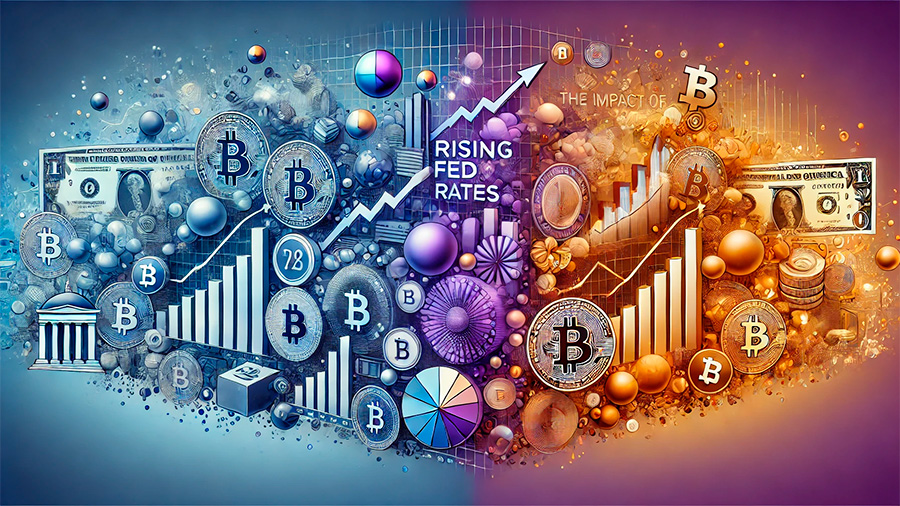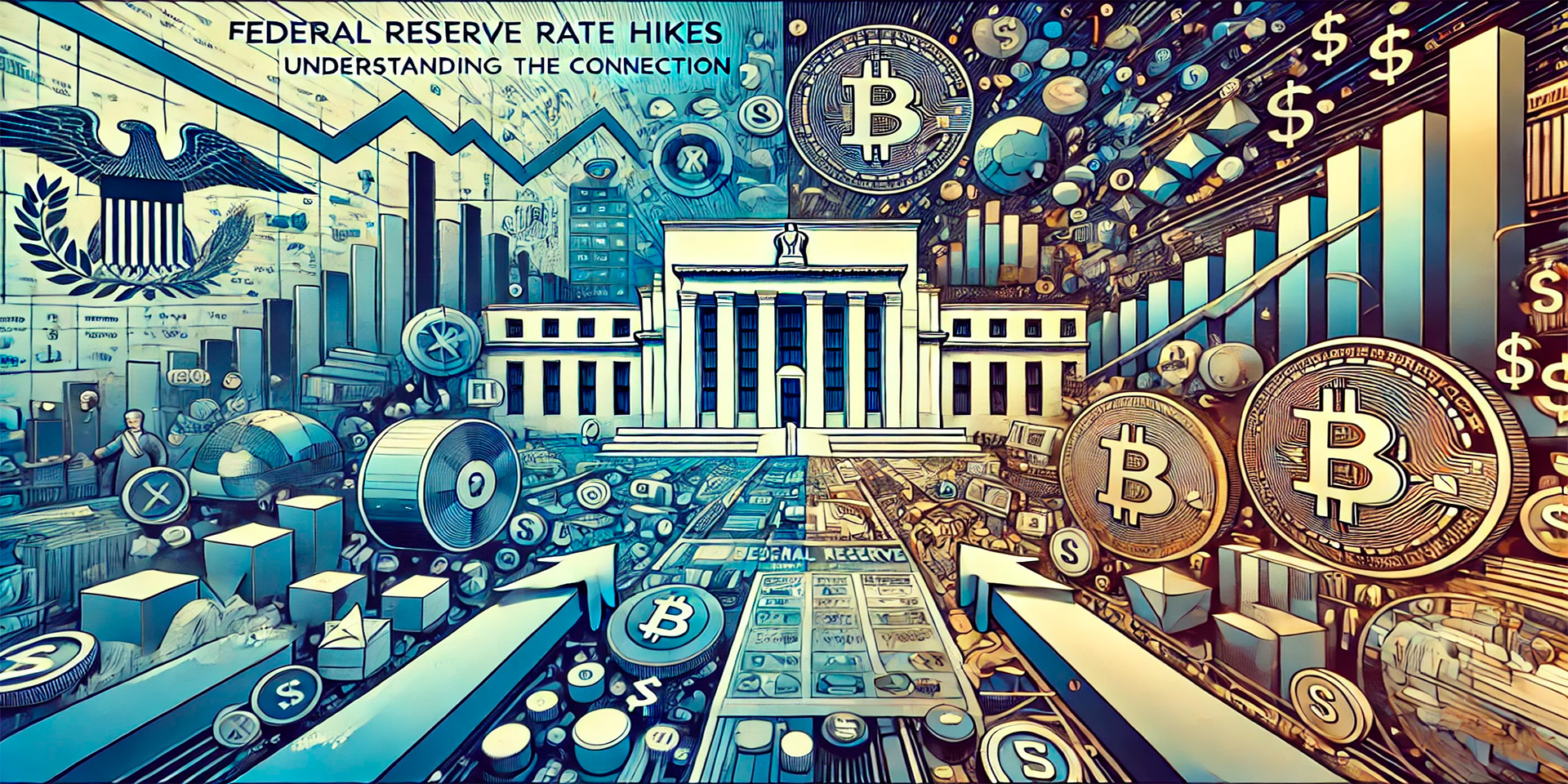The cryptocurrency market, known for its volatility and rapid price swings, is not immune to macroeconomic factors such as Federal Reserve (Fed) rate changes. While cryptocurrencies operate outside traditional financial systems, their market dynamics are influenced by the broader economic landscape, including shifts in U.S. monetary policy. In particular, changes in the federal funds rate—used by the Fed to control inflation, stimulate the economy, or cool down an overheated market—can significantly impact investor behavior in the cryptocurrency space. This article will explore how Fed rate changes affect cryptocurrency prices and the market’s overall direction.
Understanding Fed Rate Changes and Their Purpose
The Federal Reserve controls the federal funds rate, which is the interest rate at which banks lend to one another overnight. This rate serves as a benchmark for many other interest rates, including those on mortgages, car loans, and savings accounts. By adjusting the federal funds rate, the Fed can influence economic activity: lowering rates to stimulate borrowing and spending or raising rates to curb inflation and slow down an overheated economy.
When the Fed lowers interest rates, borrowing becomes cheaper, and people are generally more inclined to invest and spend. Conversely, when the Fed raises rates, borrowing becomes more expensive, which can reduce spending and investment. These monetary policy decisions ripple through various financial markets, including equities, bonds, and more recently, cryptocurrencies.
Lower Interest Rates and Their Effect on Cryptocurrencies
Low interest rates generally promote investment in riskier assets, including cryptocurrencies. When traditional investments like savings accounts and government bonds offer lower returns due to decreased interest rates, investors often seek higher yields in riskier markets. Cryptocurrencies, with their high volatility and potential for outsized gains, become an attractive option during such periods.
During periods of low Fed rates, there is typically more liquidity in the market, as borrowing becomes cheaper and capital becomes more readily available. Investors who are dissatisfied with the low returns on traditional assets may turn to cryptocurrencies, fueling demand and driving up prices. As a result, low interest rate environments often coincide with bullish trends in the cryptocurrency market.
In addition, the low-interest-rate environment often leads to increased speculation in digital assets. Many investors are willing to take on more risk to chase higher returns, leading to greater participation in the cryptocurrency market. This influx of capital can push crypto prices higher as more money flows into the market, increasing the demand for assets like Bitcoin, Ethereum, and altcoins.
Low Rates Encourage Leverage in Crypto Markets
Another important factor is the use of leverage in cryptocurrency trading. Low interest rates reduce the cost of borrowing, making it easier for investors to take on debt to invest in cryptocurrencies. This can lead to amplified buying power in the market as traders borrow money to increase their positions, further pushing up prices during bullish periods.
However, this increased use of leverage also introduces greater risk to the market. While borrowing to invest can generate significant gains during a bull market, it also magnifies losses if the market turns bearish. When Fed rates eventually rise, the cost of leverage increases, potentially leading to liquidations and price drops as over-leveraged investors are forced to sell their holdings to cover their debt.

The Impact of Rising Fed Rates on Cryptocurrencies
When the Fed raises interest rates, the effects on the cryptocurrency market can be more complex. Rising rates typically signal a tightening of monetary policy, aimed at cooling down the economy and controlling inflation. As borrowing becomes more expensive, both retail and institutional investors often reassess their portfolios, reducing exposure to riskier assets like cryptocurrencies.
Reduced Appetite for Risk
Higher interest rates generally reduce the appetite for risk, as safer investments like bonds and savings accounts start offering more attractive returns. With the potential for higher yields on traditional assets, investors may be less inclined to keep their money in volatile markets like cryptocurrencies. This shift in sentiment can lead to a sell-off in the crypto market, causing prices to decline.
As traditional investments become more appealing, many institutional investors, who have increasingly entered the crypto space in recent years, may pull back their positions in digital assets. The reduction in institutional demand can contribute to downward pressure on cryptocurrency prices, as these large players tend to have a significant influence on market movements.
Impact on Liquidity and Market Volatility
Higher Fed rates also affect liquidity in the financial markets. As borrowing costs rise, it becomes more expensive for investors to access capital, reducing the amount of money flowing into riskier assets. This reduction in liquidity can have a significant impact on the cryptocurrency market, which often relies on inflows from new investors to sustain price increases.
Additionally, rising interest rates tend to increase market volatility. As investors adjust to the new economic environment, they may react quickly to news and market movements, leading to more frequent and sharper price swings in the crypto market. This heightened volatility can make it more challenging for investors to predict price trends, further discouraging participation in the market.
Correlation Between Crypto and Other Asset Classes
In recent years, the cryptocurrency market has become increasingly correlated with other asset classes, such as equities and tech stocks. During periods of low interest rates, investors have treated cryptocurrencies similarly to growth stocks, pouring money into both asset classes in search of high returns. However, when interest rates rise, both equities and cryptocurrencies often face downward pressure as investors rotate into safer, income-generating assets like bonds or dividend-paying stocks.
This correlation suggests that cryptocurrencies may not be as insulated from traditional financial markets as some early proponents had claimed. While crypto was once viewed as a “hedge” against inflation or market downturns, its behavior during periods of rising Fed rates has shown that it is often subject to the same market forces as other risk assets.
Bitcoin as a Hedge Against Inflation
Some investors see Bitcoin and other cryptocurrencies as a hedge against inflation, particularly in a low-rate environment where fiat currencies may lose value. This narrative has gained traction in recent years as inflation concerns have grown. However, the effectiveness of Bitcoin as an inflation hedge is still debated. While Bitcoin’s limited supply is often compared to gold, its extreme volatility can make it less reliable as a store of value in the short term.
As the Fed raises rates to combat inflation, Bitcoin’s role as an inflation hedge may become more prominent, especially if inflation continues to outpace interest rate hikes. However, its price movements will also be influenced by investor sentiment and broader market conditions, which can lead to unpredictable outcomes.

Long-Term Impact of Fed Rate Changes on Cryptocurrency Market Maturity
While short-term fluctuations in Fed rates can have immediate effects on cryptocurrency prices, the long-term impact of these changes may contribute to the overall maturation of the cryptocurrency market. As the market grows and attracts more institutional investors, cryptocurrencies will likely continue to be influenced by global economic factors, including central bank policies.
Institutional Adoption and Market Stability
As institutional adoption of cryptocurrencies increases, the market is expected to become more stable and less susceptible to the extreme volatility seen in earlier years. However, institutional involvement also means that cryptocurrencies will be more closely tied to macroeconomic factors, such as Fed rate decisions. This could lead to more predictable, albeit still volatile, market behavior as cryptocurrencies begin to move in tandem with other risk assets.
Over time, the cryptocurrency market may become less reactive to short-term Fed rate changes as it matures and integrates more fully into the global financial system. As more sophisticated investment strategies and risk management tools are developed for digital assets, the market could become more resilient to the swings caused by rate hikes and cuts.
The Role of Decentralized Finance (DeFi)
Decentralized Finance (DeFi) is also playing a growing role in shaping the cryptocurrency market. DeFi platforms offer financial services, such as lending, borrowing, and earning interest, without the need for traditional intermediaries. As interest rates rise, DeFi could present an alternative for investors seeking higher yields in a tightening monetary environment.
However, DeFi platforms are not immune to Fed rate changes either. Rising rates could lead to reduced participation in DeFi protocols, particularly if traditional financial products offer more attractive returns. On the other hand, the innovation and flexibility offered by DeFi may continue to attract investors who prefer decentralized systems over traditional finance, even in a higher-rate environment.
Conclusion: Navigating the Cryptocurrency Market Amid Fed Rate Changes
The cryptocurrency market is heavily influenced by Fed rate changes, as shifts in monetary policy affect investor sentiment, liquidity, and risk tolerance. Lower Fed rates tend to boost demand for cryptocurrencies by encouraging risk-taking and making borrowing cheaper, while rising rates often lead to reduced appetite for risky assets and increased market volatility.
As the cryptocurrency market continues to mature, its response to Fed rate changes may evolve. Institutional adoption, growing correlation with traditional asset classes, and the rise of decentralized finance all contribute to the market’s ongoing transformation. For investors, understanding how macroeconomic factors like Fed rate changes impact cryptocurrency prices is essential for making informed decisions and navigating the market in both bullish and bearish environments.






